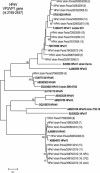Human parechovirus infections in patients admitted to hospital in Northern Italy, 2008-2010
- PMID: 22337310
- PMCID: PMC7166678
- DOI: 10.1002/jmv.23197
Human parechovirus infections in patients admitted to hospital in Northern Italy, 2008-2010
Abstract
Human parechoviruses (HPeVs) infection is associated with a wide range of clinical syndromes such as respiratory, gastrointestinal, neurologic diseases, and neonatal sepsis-like illness. The main objective of this study was to investigate the epidemiology of HPeVs infection in hospitalized patients in a period of 2 years. Respiratory samples from 3,525 patients with respiratory syndrome, cerebrospinal fluid (CSF) from 340 patients with neurologic syndrome as well as CSF and plasma samples from five neonatal patients with sepsis-like illness collected from October 2008 to 2010 were tested retrospectively using HPeV-specific real-time RT-PCR. Phylogenetic analysis of VP3/VP1 region was performed on the positive samples. Fourteen out of 3,525 (0.4%) patients with respiratory syndrome and five out of five patients with sepsis-like illness were positive for HPeV. In 3/5 patients with sepsis-like illness multiple samples (e.g., stool, plasma, CSF, or respiratory samples) were available, and HPeV was found in all specimens. In contrast, no positive CSF was detected among the 340 patients with neurologic syndromes. Eleven patients (57.9%) were infected with HPeV1 strain, 7 (36.8%) with HPeV3, and 1 (5.3%) with HPeV6 strains. Ten of the 14 HPeV patients with respiratory syndrome were co-infected with other respiratory viruses (eight with rhinovirus and two with coronavirus OC43). All five patients with sepsis-like illness were less than 1 month of age and were infected with HPeV3. Although not circulating at high frequency and unlikely to cause respiratory syndrome, HPeV was associated with severe clinical syndromes in a minority of newborns.
Copyright © 2012 Wiley Periodicals, Inc.
Figures

References
-
- Baumgarte S, de Souza Luna LK, Grywna K, Panning M, Drexler JF, Karsten C, Huppertz HI, Drosten C. 2008. Prevalence, types, and RNA concentrations of human parechoviruses, including a sixth parechovirus type, in stool samples from patients with acute enteritis. J Clin Microbiol 46: 242– 248. - PMC - PubMed
-
- Benschop KS, Schinkel J, Minnaar RP, Pajkrt D, Spanjerberg L, Kraakman HC, Berkhout B, Zaaijer HL, Beld MG, Wolthers KC. 2006b. Human parechovirus infections in Dutch children and the association between serotype and disease severity. Clin Infect Dis 42: 204– 210. - PubMed
Publication types
MeSH terms
Substances
Associated data
- Actions
- Actions
- Actions
- Actions
- Actions
- Actions
- Actions
- Actions
- Actions
- Actions
- Actions
- Actions
- Actions
- Actions
- Actions
- Actions
- Actions
- Actions
- Actions
- Actions
- Actions
LinkOut - more resources
Full Text Sources

